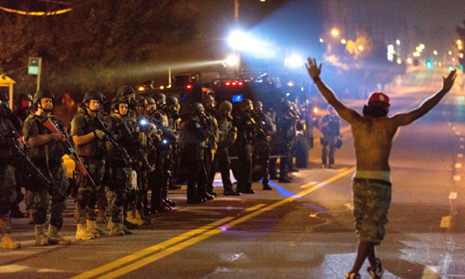Ferguson and Benghazi

Both events tell us something about the passions of our times. It was quickly apparent what had happened at Ferguson. Michael Brown was not on his knees, hands up, when he was shot. He was rushing at the police officer.
Did he deserve to die? No. But did Darren Wilson shoot him for no reason? Again, no. Did the Justice Department later find that Ferguson’s police force was a cesspool of racism, incompetence and corruption? Yes. But did any of that mean that Wilson killed Brown in cold blood or that Brown was shot because he was black? No and no.
A grand jury studied what happened and did not indict Wilson. Eric Holder’s Justice Department reached the same conclusion. Let me offer another conclusion: If Brown was not criminally shot because he was black, then possibly the cop was accused because he was white. Who was the stereotyped individual here?
Still, Ferguson became a cause — and has remained one. It is a town of only about 21,000 — a bad day at Yankee Stadium — and yet it has repeatedly been the lead story for many news organizations. It was made to represent institutional racism across the nation, but it is, really, a tiny nondescript place where a supposedly racist and unjustifiable killing by the police did not occur. It does, though, conform to the very keen feelings of people who see white racism everywhere.
Benghazi plays a similar role on the right, encapsulating all that is supposedly wrong with President Obama’s foreign policy — not to mention Hillary Clinton’s stewardship of it. A House select committee has been formed to look into the incident. It is treading where previous committees have wandered off — trying to show that Obama or Clinton did nothing to save the lives of the American ambassador and three others. There’s blood on their hands — if only it could be found.
That — the deaths of Americans — is the heart of the matter, not whether Susan Rice was given dishonest talking points for the Sunday talk shows. A certain amount of confusion had to be expected that chaotic morning in September 2012 and a certain amount of cynicism directed at an administration that was doing its best not to label the incident terrorism. Somewhere, possibly hidden in the Smithsonian, is an example of perfectly honest talking points, but no one has ever seen them.
We live in a time where facts that do not fit an ideology or grievance are merely disregarded — or alternative ones concocted: Do you think campus rape is a problem not taken seriously? Then pillory the accused, deprive them of basic rights, say your critics are blaming the victim — and fling the dross of questionable statistics into the air.
Do you think black men are casually killed by the police? Then concoct a statistic, as Arlene Eisen has done, and watch with satisfaction as it goes viral. The widely used “#every28hours” hashtag turns out to be a hash of statistics and hunches, all of it infused by leftist cant about “the national security state” and the “perpetual war on black people.”
Do you think that the African American men who are killed by the police are solely victims of racism? If so, then ignore that, in 2013, about 44 percent of the nation’s murder victims were black — and some 90 percent of those victims were killed by other black people. There is a problem here, and it does not go away by yelling “Racist, Racist” at the numbers.
Do you think the bureaucracy is both liberal and evil? Then proclaim some foul-up at the IRS a second Watergate. It has, I know, disappointed — no movies in the works yet — but another scandal will soon appear. Facts are not really needed.
Now for a blogger alert: Please note that I do not think racism is no longer a problem or that campus rape has not been an unaddressed horror. I know better. But I also believe that distorting the facts can impede progress. The dead of anywhere — Ferguson or Benghazi — do matter. And so does the truth.















































